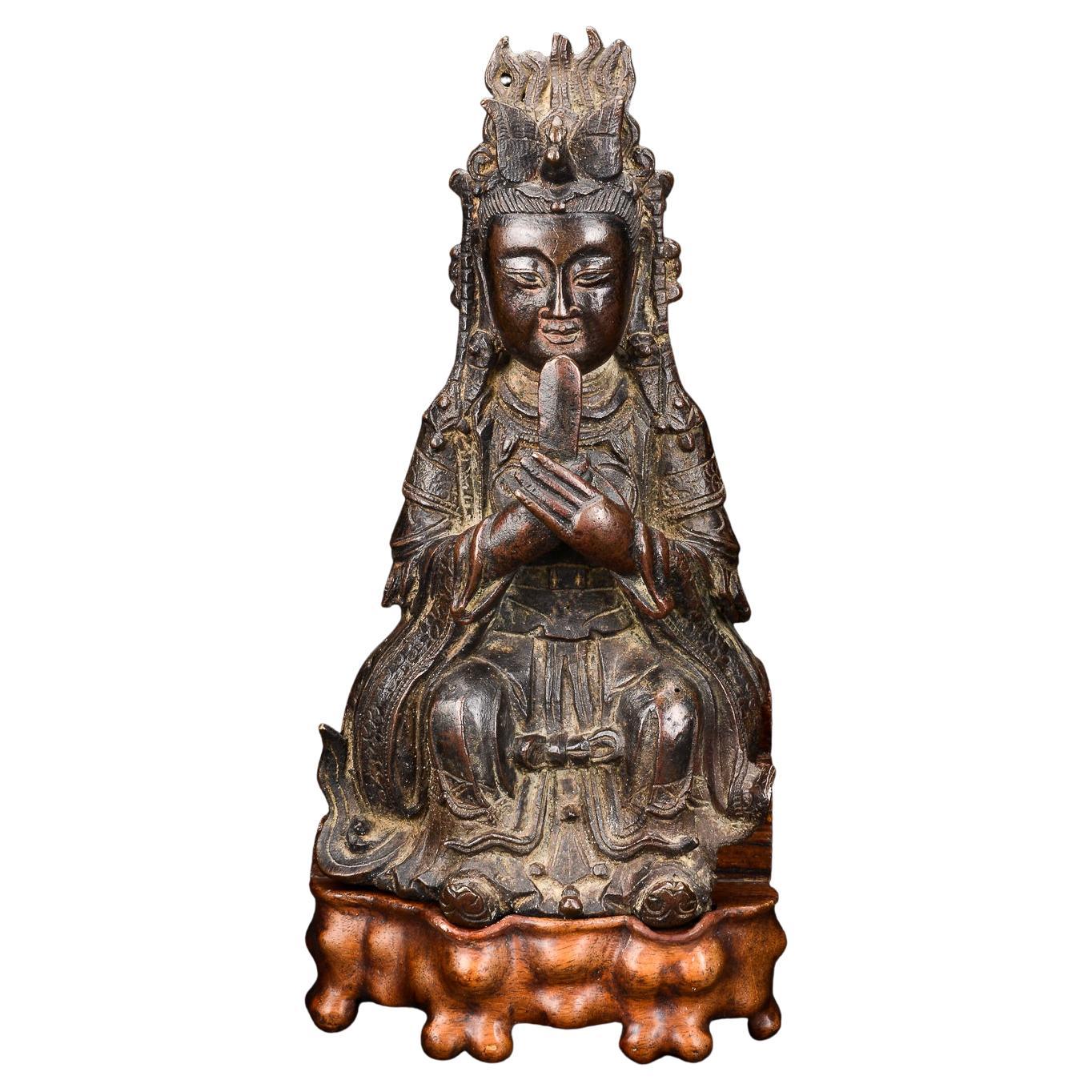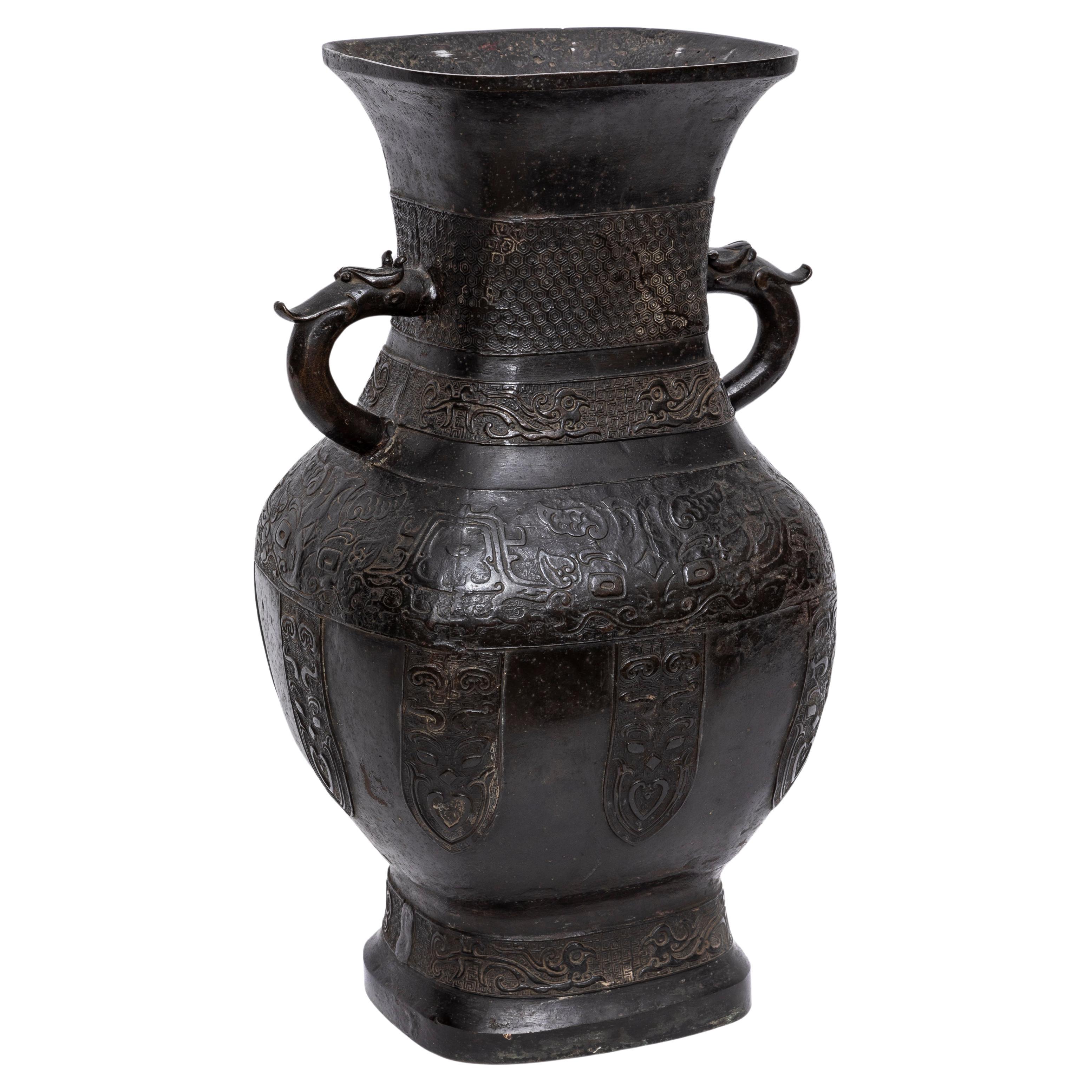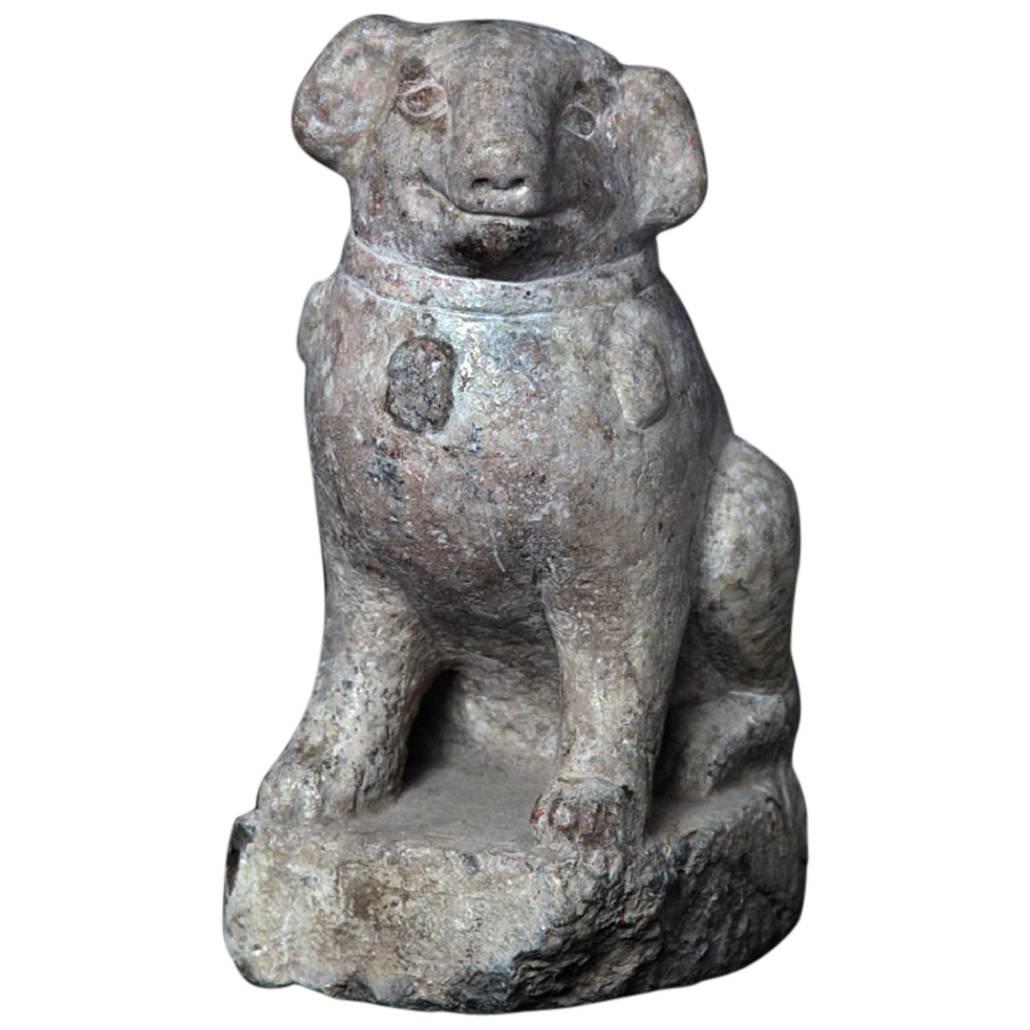Items Similar to Ming Dynasty Bronze Vase ( 1368- 1644 )
Want more images or videos?
Request additional images or videos from the seller
1 of 9
Ming Dynasty Bronze Vase ( 1368- 1644 )
About the Item
Chinese Ming dynasty bronze vase ( 1368- 1644 ) A genuine Ming vase dating from the early to middle of the ming dynasty. Archaistic decoration Taotie mask design handles and Taotie ("monster"} mask decoration .
A rare and nicely patinated bronze vase in good antique condition.
Please see detailed photos as part of the condition report .
High: 28 cm
Max Width: 19 cm
- Dimensions:Height: 11.03 in (28 cm)Width: 7.49 in (19 cm)Depth: 7.49 in (19 cm)
- Materials and Techniques:Bronze,Cast
- Place of Origin:
- Period:
- Date of Manufacture:( 1368- 1644 )
- Condition:Wear consistent with age and use. Minor structural damages. Minor damage to the base, but all consistent with age and use.
- Seller Location:Hoddesdon, GB
- Reference Number:1stDibs: LU9494237349362
About the Seller
New to 1stDibs
Joined in the past six months.
5.0
Gold Seller
These expertly vetted sellers are highly rated and consistently exceed customer expectations.
Established in 1987
1stDibs seller since 2023
5 sales on 1stDibs
Typical response time: 1 hour
- ShippingRetrieving quote...Ships From: Hoddesdon, United Kingdom
- Return PolicyA return for this item may be initiated within 3 days of delivery.
More From This SellerView All
- Chinese Ming Dynasty Martaban JarLocated in Hoddesdon, GBChinese Ming Dynasty 1368 - 1644 Martaban Jar . Dates to the early Ming period . High neck and wide shoulders , brown slip glaze , unglazed base , loop-handles. rolled lipped rim ty...Category
Antique 17th Century Chinese Ming Ceramics
MaterialsClay
- Chinese Qing Dynasty Lacquered Six-Panel ScreenLocated in Hoddesdon, GBChinese hand-painted and lacquered Coromandel 6-Panel Room Divider/Screen dating back to the late Qing dynasty. A truly stunning example , each panel is created using gesso before b...Category
Antique Early 1900s Chinese Chinese Export Screens and Room Dividers
MaterialsLacquer
- 18th Century Chinese Lacquered Cabinet - Qing DynastyLocated in Hoddesdon, GBA truly Beautiful 18th century Chinese 2 door lacquered cabinet with intricately carved apron , dating to the Mid-Qing Dynasty . This magnificent cabinet is embellished with gildin...Category
Antique Mid-18th Century Chinese Cabinets
MaterialsElm
- Qing Dynasty Chinese Red Lacquered Cabinet - Shanxi ProvinceLocated in Hoddesdon, GB18th-century Chinese two-door red lacquered cabinet from Shanxi, China, dating back to the Qing period . This stunning cabinet is embellished with gilding and hand-painted scenes to...Category
Antique Mid-18th Century Chinese Chinese Export Cabinets
MaterialsElm
- Bernard Rooke Studio Pottery / Vase Circa 1960sBy Bernard RookeLocated in Hoddesdon, GBBernard Rooke Studio Pottery vase . A rare vintage 1960s example. Made by the renowned British artist, potter, Bernard Rooke, this piece is a wonderful example of his work . Be...Category
Vintage 1960s British Brutalist Vases
MaterialsPottery
- Bernard Rooke Studio Pottery / Brutalist Vase C. 1960sBy Bernard RookeLocated in Hoddesdon, GBBernard Rooke Studio Pottery Chalice is a rare vintage example from the 1960s. Made by the renowned British artist and potter, Bernard Rooke, this piece is a true testament to his ar...Category
Vintage 1960s British Brutalist Vases
MaterialsPottery
You May Also Like
- Bronze Figure of a Seated Luohan, Ming Dynasty, 1368-1644Located in Torino, ITCast seated wearing a simple robe with his right hand resting on the hilt of a snake-entwined sword, the left hand held aloft, his face with meditative expre...Category
Antique Early 1600s Chinese Ming Sculptures
MaterialsBronze
- Longquan Celadon Figurine, Ming Dynasty (1368-1644)Located in seoul, KRThis sculpture is a Longquan celadon from the Ming Dynasty, renowned for its rich and jade-like green glaze. The figurine is likely a representation of a Buddhist deity or a revered scholar, showcasing the calm aesthetic expressions and graceful contours prevalent during the era. The spectrum of celadon glaze ranges from a dense grey stoneware to a nearly white porcelain texture, with unglazed parts revealing a terracotta brown upon firing. Such pieces were often part of household altars, reflecting the era's spiritual devotion. This artifact would be a treasured exhibit in any museum's Asian art collection, symbolizing both religious reverence and artistic excellence. Period: Ming Dynasty (1368-1644) Region: Longquan, China Medium: Stoneware - Celadon glazed, with a range from heavy grey to almost white porcelain-like material Type: Sculpture Height : 24.5 cm Provenance : Acquired in 1999, Hongkong * Ming Dynasty Longquan Celadon Longquan celadon from the Ming Dynasty typically exhibits a more robust and heavier stoneware body compared to its Song Dynasty predecessors. The Ming era saw an evolution in celadon glaze, achieving a wider spectrum of green hues, from olive to bluish-greens. Ming celadons...Category
Antique 15th Century and Earlier Chinese Ming Antiquities
MaterialsCeladon
- Bixia Yuanjun Figure of Bronze Dated Ming Dynasty, 1368-1644Located in London, GBBixia Yuanjun figure of bronze dated Ming Dynasty 1368-1644. Base of hardwood. Height excluding base 26cm; Heigh including base 31cm. Condition: Corrosion on reverse/back; ...Category
Antique 15th Century and Earlier Chinese Ming Antiquities
MaterialsBronze
- A Ming Dynasty Patinated Bronze Relief Work Vase Turned to a LampLocated in New York, NYHailing from the Ming period in 16/17th century, this monumental bronze vase is a fine example of the auspicious decor and markings unique to Chinese furnishings. The vase is cast wi...Category
Antique 17th Century Chinese Ming Metalwork
MaterialsBronze
- Chinese Bronze Scholar Vase with Taotie, Ming/Qing Dynasty, 17th century, ChinaLocated in Austin, TXA small and interesting cast bronze archaistic scholar vase with loose ring handles and taotie mask design, late Ming or early Qing Dynasty, mid 17th century, China. The small vase of archaistic hu form, and cast with archaistic designs. Sitting on a tall splayed ring foot, the round body is cast with a large band featuring a ferocious taotie (ogre) mask. The taotie mask in this case id decidedly feline, with a ruyi shaped snout above a whiskered mouth. Two flanges stick out to either side of the mask, reminiscent of ears. A wide, tall neck rises from the body, terminating in a slightly everted mouth. The archaistic cast design on the neck is not as clear, but most likely represents Fusang, a mythical island in the Eastern Sea where the legendary Fusang tree grows. The Fusang tree, home to the mythical Sun Bird...Category
Antique Mid-17th Century Chinese Qing Scholar's Objects
MaterialsBronze
- Important Ancient Chinese Effigy Pug Dog, Ming Dynasty 1368-1644Located in South Burlington, VTChina, a carving of a canine “Pug”, Ming Dynasty, 1368-1644 CE Dimensions: 38 cm, 15” High Photographs taken indoors and out of doors for your viewing pleasure. The hand carved limestone beast shown on its haunches with naturalistic joyful expression and a well defined compact head, ears, noes, eyes, feet, and tail parted to one side on reverse with distinctive collar ornament seated four square on a thick base all-over showing a weathered surface from significant age. Formerly exhibited “Asia Week” New York City, Fuller Building, Hutton Gallery 2006. Provenance: ex collection luoyang, Henan Province, China. Includes custom display base as shown Catalog reference: 35 years collecting 35 treasures, Number 35, p.76 (photo) In ancient China, it is a well-known fact that several types of small dogs were bred and were favored pet gifts between emperors and kings including Lion Dogs, Pekingese and Lo-sze breeds. Some Lo-sze are pictured wearing collars with bells a frequent combination fancied by European royalty of the seventeenth and eighteenth centuries. Lo-sze or pugs were prized for their compact body, good bones, flat face, square jaw, short coat, curled tail, side set back ears, and temperate disposition. History: Placing stone animals in important tombs can be traced back at least to the Qin Dynasty (221-206 BCE), some two thousand years ago. In ancient times, stone animals and human figures placed before imperial tombs symbolized royal power and privilege in addition to decorative functions. The first Ming tomb...Category
Antique 15th Century and Earlier Chinese Ming Sculptures and Carvings
MaterialsLimestone
Recently Viewed
View AllMore Ways To Browse
Tibetan Censer
Samurai Helmet Art
Hammered Urli Vessel With Handles
Tibetan Singing
Antique Brass Towel Ring
Bronze Elephant Incense
Chinese Belt Hook
Solid Perfume Container
Japanese Bronze Brazier
Tibetan Tea Pot
Wedding Bangle
Zi Jin Cheng Vase
Asian Copper Art
Koro Antique
Antique Metalworking Hand Tool
Japanese Bronze Foo
Meiji Period Bronze Bowl
Large Dragon Pot





